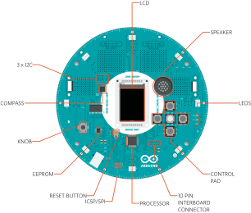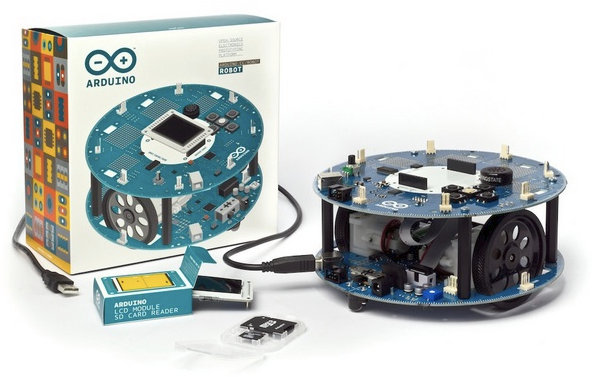On top of announcing its first Linux powered board, Arduino also announced its first official robot at Maker Faire Bay Area called “Arduino Robot”. The robot comes with 2 wheels and two boards:
- The Motor Board controlling the motors.
- The Control Board reading sensors and deciding how to operate.
Each board, based on Atmel ATmega32u4 MCU, is programmable like any other Arduino board using the Arduino IDE.
Control board specifications:

- MCU – Atmel ATmega32u4 @ 16 MHz with 32KB flash, 2.5KB SRAM, and 1KB EEPROM
- External Storage – 512 Kbit EEPROM (I2C) + SD card reader for FAT16 formatted cards
- Display – Full color LCD over SPI communication
- I/O interfaces:
- 5x Digital I/O Pins
- 6x PWM Channels
- 4x Analog Input Channels (of the Digital I/O pins)
- 8x Analog Input Channels (multiplexed)
- Misc – 5 keys keypad, Knob potentiometer attached to analog pin, 8 Ohm speaker, digital compass
- “Playground” – 3x I2C soldering ports, 4x Prototyping areas
- Power – 5V
Motor board specifications:

- MCU – Atmel ATmega32u4 @ 16 MHz with 32KB flash, 2.5KB SRAM, and 1KB EEPROM
- I/O interfaces:
- 4x Digital I/O Pins
- 1x PWM Channels
- 4x Analog Input Channels (same as the Digital I/O pins)
- 5 IR line following sensors
- “Playground” – 1x I2C soldering ports, 2x prototyping areas
- Misc – Trimmer for movement calibration
- Power – 5V. Input Voltage 9V to battery charger, AA battery slot four alkaline or NiMh rechargeable batteries.
Hardware, software and documentation are all freely available and open-source. You can power and program it by connecting it to one of the USB ports of your computer (Windows, Linux, or Mac OS X) . You’ll have to insert 4 rechargeable batteries to use it without computer, as for safety reason, the motors are disabled when it is powered via USB.
The Arduino was available for purchase at the Maker Faire on May 17-19 (but I could not find the price), and will be available to all early July 2013 via Arduino store and the company’s distributors. Further information is available on Arduino Robot page.
Via Atmel Blog and Liliputing

Jean-Luc started CNX Software in 2010 as a part-time endeavor, before quitting his job as a software engineering manager, and starting to write daily news, and reviews full time later in 2011.
Support CNX Software! Donate via cryptocurrencies, become a Patron on Patreon, or purchase goods on Amazon or Aliexpress





